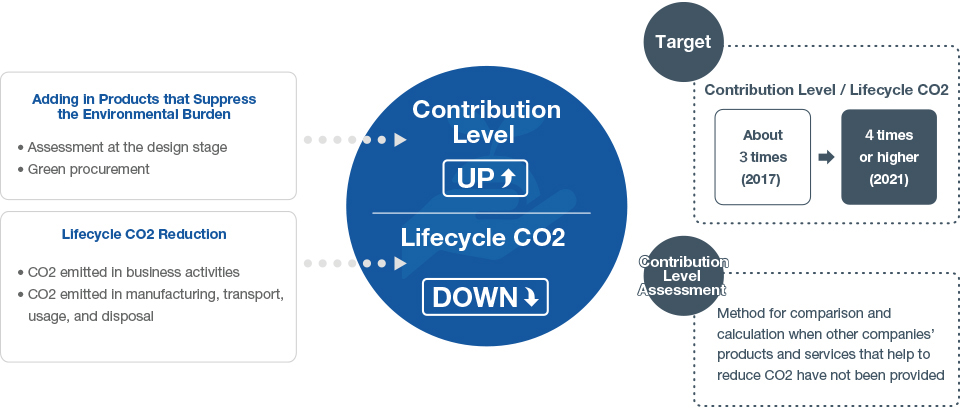
At Optex, we are moving ahead with environmental conservation activities through manufacturing focused on developing products, which can help customers who have installed Optex eco-conscious designs and sensors to save energy and resources. Optex sensors consume a miniscule amount of power on their own. When installed into a system, the sensors can be substantially effective in reducing the greenhouse gas emissions of the entire system. Through Optex products and services, we are carrying out initiatives to realize a sustainable society and preserve the earth’s environment from a global perspective.
- We are also raising the environmental awareness of all Optex executives and employees by promoting an environmental management system.
- We recognize that environmental conservation is a part of corporate social responsibility (CSR), and we strictly comply with the relevant laws, regulations and standards, while continuing to do what we can as a company to improve and enhance the environment.
- We are striving to ensure Optex corporate activities in all fields are in harmony with the environment.
We are also making an effort to use resources more effectively and energy more efficiently, and to reduce industrial waste in all of our corporate activities, by following a basic approach of reduce, recycle and reuse.
- Optex carries out its own environmental assessment at the design stage of new products. We are moving forward with environmentally-conscious design by assessing factors such as how much a new model conserves resources and energy compared to the previous model, and if it uses recycled materials.
We are also striving to raise awareness of environmental conservation through our ongoing initiatives, including the horizontal roll out of factors identified in the assessment that can make our products, services and corporate activities more environmentally friendly. - Optex sensors have always been a low-power consumption and eco-friendly product. For example, these sensors only operate when they detect people or objects, and operate systems only when needed.
Recently as a part of our business strategy, we have also been actively launching products that suppress the environmental burden. These include a shift toward LED lighting and battery-powered devices, and they are some of the energy-saving products we offer that are also hugely beneficial to our customers. - Furthermore, in addition to the six hazardous substances of lead, mercury, cadmium, hexavalent chromium, PBB, and PBDE, which are stipulated for restricted use in the RoHS Directive, four other substances of DEHP, BBP, DBP and DIBP have been added to this list. By July 2019, parts that contain any of these hazardous substances that infringe the RoHS Directive will not be used at Optex.
We are also carrying out green procurement in compliance with the revised WEEE (Waste Electrical and Electronic Equipment) Directive for the disposal of electrical and electronic devices. - Since 2016, we have been looking at the life cycle of Optex products from the planning stage to their disposal.
Specifically, we have been estimating the effects of improved transport efficiency by setting up hub warehouses and revising transport routes, and also focusing on product disposal and the loss from irregular transport by ships, airplanes, and other means in terms of both F cost* and CO2. Our aim is to improve product quality, while also reducing CO2 emissions.
* F Cost = Failure cost
Optex Environmental Activities
Optex environmental activities span a wide range of processes in the value chain from purchasing and procurement to research and development, production, usage, disposal, and recycling.
- Improving the contribution level and environmental efficiency
- Carrying out low carbon and environmental assessment activities (energy- and resource-saving designs)
- Reducing defects (limiting irregular transport and disposals, etc.)
- Practicing eco-friendly activities (saving power, promoting black and white photocopying, adjusting the air conditioning temperature, implementing Cool Biz and Warm Biz initiatives, purchasing power-saving OA devices, reducing overtime, implementing sorting/disposal and recycling, using rental cars, etc.)
Main Initiatives by Business Field
Security Business
- Expanding the lineup of battery-powered products
- Using common designs to create more products with low electrical current consumption
- Improving efficiency by simplifying construction and installation work

Automatic Door and Industrial Door Business
- Standardizing parts, and prioritizing the use of low power consumption parts
- Balancing raising product value with improving environmental efficiency
- Developing and launching products* that use energy harvesting technology (generating power using energy in the environment)*
- Using power generated from the force of pushing

Lighting Business
- Using LED lighting in sensor lights (using LED for all models in 2016)*
- Making products much smaller and lighter
- Developing and using more smart lighting (sensors and dimmable lights)
- Enhancing the lineup of solar lights
- Power consumption is 1/5 or less of halogen lights

Environmental Business
- Developing water quality monitoring devices
- Moving forward with the use of IoT

Others
- Launching energy harvesting products for use in the automation of buildings
- Carrying out on-site environmental training: O'PAL
- Encouraging employees to work smarter

Environmental Achievement

